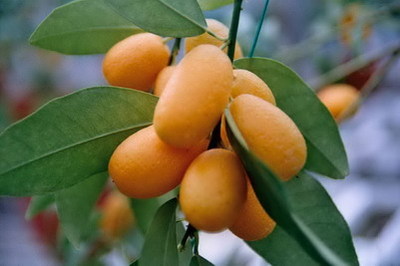Kumquat
Kumquat, which is originated in China, was a favorite of China's Qing Dynasty nobles. It's believed kumquats were first introduced to Taiwan's Yilan area from mountainous areas of China's Jiangxi Province and then introduced to Yilan in the 18th Century.In Taiwan, the kumquat goes by various names, including golden jujube and golden chu. People in Yilan, however, call it milk citrus.The kumquat is golden yellow fruit about the size of a thumb-joint. The fruit has always been a favorite in Taiwan because the harvest season often marks the coming of the Chinese Lunar New Year and phonetically, "chu" is close to the word for "luck, " so the fruit is therefore thought to bring luck for the coming year.
 Yilan's abundant rainfall makes the region the major production area for kumquats in Taiwan, with most of the orchards located in Jiaosi and Yuanshan townships.The kumquat tree and fruit are among the smallest of the citrus genus and it is the only type of citrus of which the rind can be eaten. It is harvested from November to March.
Yilan's abundant rainfall makes the region the major production area for kumquats in Taiwan, with most of the orchards located in Jiaosi and Yuanshan townships.The kumquat tree and fruit are among the smallest of the citrus genus and it is the only type of citrus of which the rind can be eaten. It is harvested from November to March.
There are three major types of kumquat grown in Taiwan, the two most common varieties of which are the round kumquat and the Nagami kumquat, the latter usually used for preserved fruit and jam.The round kumquat, on the other hand, has bitter rind and sour flesh and is usually grown for ornamental use.The kumquat is an excellent source of vitamin A, B, C, P, protein dietary fiber and carotene. It also contains sugar, kumquat glycoside, iron, calcium and phosphorous.
Some simple tips:
1.Choosing kumquats
Kumquats should be fresh with an oval shape and golden yellow skin.
2.Storing kumquats
Keep them in a well-ventilated place away from direct sunlight after harvesting, or store them at 5°C. Preserved kumquats should be refrigerated after opening.
